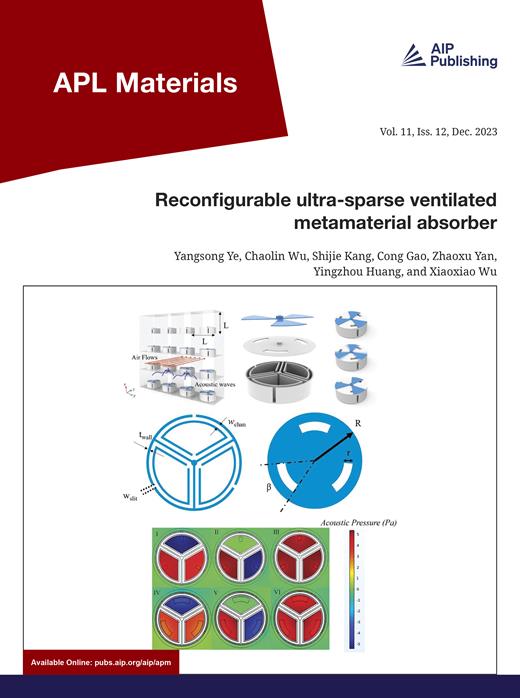低损耗有机铁磁体 V[TCNE]x∼2 中铁磁共振的原位电场控制
IF 5.3
2区 材料科学
Q2 MATERIALS SCIENCE, MULTIDISCIPLINARY
引用次数: 0
摘要
我们在将低损耗、基于分子的室温铁磁体四氰基乙烯钒(V[TCNE]x∼2)与 PMN-PT 压电换能器机械耦合的装置中演示了铁磁共振(FMR)的间接电场控制。在对 V[TCNE]x 薄膜施加应变时,FMR 频率被调谐到共振线宽的 6 倍以上,而对于 α = 6.5 × 10-5 的样品,吉尔伯特阻尼没有变化。我们证明这种调谐效应是由于薄膜中与应变相关的磁各向异性造成的,并发现磁弹性系数 |λs| ∼ (1-4.4) ppm,这与密度泛函理论计算和磁弹性理论的理论预测相吻合。我们注意到应变调谐 FMR 的应用空间正在迅速扩大,因此定义了磁致伸缩材料的新指标--磁致伸缩敏捷度,该指标由磁弹性系数与 FMR 线宽之比给出。这种灵敏度可以直接比较磁致伸缩材料在需要应变调制超低损耗磁共振的磁电应用中的功效。通过这一指标,我们发现 V[TCNE]x 与其他磁致伸缩材料(包括 YIG 和 Terfenol-D)相比具有竞争力。这种将超窄线宽和磁致伸缩结合在一起的系统可直接集成到功能器件中,而无需在薄膜几何形状中进行异质集成,有望为电场调谐微波器件(从低功耗、紧凑型滤波器和环行器到量子信息科学与技术中的新兴应用)提供前所未有的功能。本文章由计算机程序翻译,如有差异,请以英文原文为准。
In situ electric-field control of ferromagnetic resonance in the low-loss organic-based ferrimagnet V[TCNE]x∼2
We demonstrate indirect electric-field control of ferromagnetic resonance (FMR) in devices that integrate the low-loss, molecule-based, room-temperature ferrimagnet vanadium tetracyanoethylene (V[TCNE]x∼2) mechanically coupled to PMN-PT piezoelectric transducers. Upon straining the V[TCNE]x films, the FMR frequency is tuned by more than 6 times the resonant linewidth with no change in Gilbert damping for samples with α = 6.5 × 10−5. We show this tuning effect is due to a strain-dependent magnetic anisotropy in the films and find the magnetoelastic coefficient |λs| ∼ (1–4.4) ppm, backed by theoretical predictions from density-functional theory calculations and magnetoelastic theory. Noting the rapidly expanding application space for strain-tuned FMR, we define a new metric for magnetostrictive materials, magnetostrictive agility, given by the ratio of the magnetoelastic coefficient to the FMR linewidth. This agility allows for a direct comparison between magnetostrictive materials in terms of their comparative efficacy for magnetoelectric applications requiring ultra-low loss magnetic resonance modulated by strain. With this metric, we show V[TCNE]x is competitive with other magnetostrictive materials, including YIG and Terfenol-D. This combination of ultra-narrow linewidth and magnetostriction, in a system that can be directly integrated into functional devices without requiring heterogeneous integration in a thin film geometry, promises unprecedented functionality for electric-field tuned microwave devices ranging from low-power, compact filters and circulators to emerging applications in quantum information science and technology.
求助全文
通过发布文献求助,成功后即可免费获取论文全文。
去求助
来源期刊

APL Materials
NANOSCIENCE & NANOTECHNOLOGYMATERIALS SCIE-MATERIALS SCIENCE, MULTIDISCIPLINARY
CiteScore
9.60
自引率
3.30%
发文量
199
审稿时长
2 months
期刊介绍:
APL Materials features original, experimental research on significant topical issues within the field of materials science. In order to highlight research at the forefront of materials science, emphasis is given to the quality and timeliness of the work. The journal considers theory or calculation when the work is particularly timely and relevant to applications.
In addition to regular articles, the journal also publishes Special Topics, which report on cutting-edge areas in materials science, such as Perovskite Solar Cells, 2D Materials, and Beyond Lithium Ion Batteries.
 求助内容:
求助内容: 应助结果提醒方式:
应助结果提醒方式:


